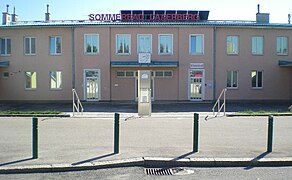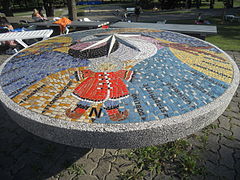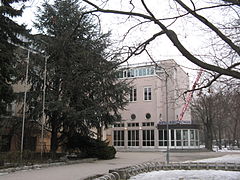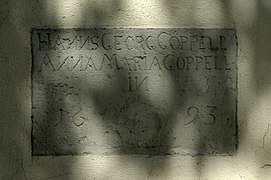Ludwig-von-Höhnel-Gasse
| Ludwig-von-Höhnel-Gasse | |
|---|---|
| Street in Vienna | |
| Basic data | |
| place | Vienna |
| District | Favoriten (10th district) |
| Connecting roads | Endlichergasse |
| Cross streets | Old estate , Fischhofgasse |
| Buildings | Laaerbergbad , Gradner Chapel , Neulandschule Laaerberg , Göppelkreuz Chapel |
| use | |
| User groups | Pedestrians , bicycle traffic , car traffic , bus route 15A |
| Technical specifications | |
| Street length | approx. 230 m |
The Ludwig von Höhnel Alley is located in the 10th Vienna district favorites . It was named in 1958 after the Africa explorer Ludwig von Höhnel , who discovered the Rudolfsee , among other things .
Location and characteristics
The short, but busy Ludwig-von-Höhnel-Gasse is part of the B225 and is of importance in terms of transport as a feeder road to the Favoriten district and thus to the Vienna Südosttangente motorway . It begins at the distribution circle, which bears the topographical name Altes Landgut, has no residential buildings and goes at house number 17-19 (the Neulandschule is off the road on the original street) as a traffic route into Endlichergasse, which becomes Theodor-Sickel- Alley opens. One block north of this confluence is a remnant of the old course of Ludwig-von-Höhnel-Gasse, which now belongs to Florian-Geyer-Gasse.
The 15A bus runs in the main part of the street. There is also a bike path here. Although the Volkspark Laaerberg is to the south of the street and leisure facilities are nearby, the Ludwig-von-Höhnel-Gasse itself is not pleasantly accessible for pedestrians because of the heavy traffic.
Remarkable structures
No. 2: Laaerbergbad
The approximately 6 hectare area of the Laaerberg bath is located at the Favoriten distribution circle on the southern slope of the Laaer Berg . It was built between 1957 and 1959 according to a design by the architect Erich Franz Leischner and is one of the most popular summer baths in Vienna. There is a sports pool, a diving tower, a wave pool and a children's paddling pool. The artistic equipment on the outside consists of four 15 m² ornamental glass mosaics by Josef Mikl , Karl Kreutzberger, Heinz Klima and Anton Krejcar from 1959 on the side facing Favoritenstrasse . Inside there are two large ceramic reliefs. Orientation plans by Leopold Schmid, also from 1959. The back wall of the showers is decorated with the mosaics Fish and Water Birds by Ferdinand Kitt (1959). The 2.30 meter high plastic discus thrower made of natural stone by Rudolf Beran was created in 1960. Play sculptures in mushroom shape with a mosaic wind rose (1960) and Two Turtles (1961) are by Ladislaus Stecker and Othmar Jarmer.
Gradner Chapel
The brick Gradner Chapel, built in 1828, stands directly on the street in front of the bathroom.
Laaerberg public park
Next to the Laaerbergbad is the steeply sloping south slope of the Laaer Berg, the large Volkspark Laaerberg, which was created as part of the southern Viennese forest and meadow belt from 1932 and in the course of the pool construction especially until 1959. The natural park has the large public park pond in the middle. There are children's playgrounds and a public toilet facility in the area. Near the pond there is an obelisk by Helmut Leherb with relief decorations on two sides, symbolizing day and night.
No. 17–19: Rector's Church and Neulandschule
Opposite the Volkspark, some distance from the northern side of the street, are the buildings of the Neulandschule Laaerberg and the church. The Church of Our Lady of the Blessed Sacrament forms a unit with the former monastery buildings surrounding it and was built from 1928 to 1929 according to plans by Bruno Buchwieser senior . The South Tyrolean Eucharist Johann Nicolussi and the pastor of the Antonskirche Heinrich Hinner initiated the establishment of the monastery complex, but only the western part of an originally symmetrically planned complex was realized. Until 1947 the church was the monastery church of the Eucharist, from 1937 to 1986 it was the parish church of Laaer Berg. It is a simple hall church with an apse in neo-Romanesque style. The pulpit of the church was carved by a deaf and mute lay brother. The side altars are consecrated to Our Lady of the Blessed Sacrament on the right and to Saint Joseph on the left. A statute shows the founder of the congregation, Father Pierre Julien Eymard , with the monstrance in his hands. The Neulandschule has been located in the monastery buildings since 1947 and operates an elementary school, secondary school and grammar school on site.
Göppelkreuzkapelle
In front of the school, directly on the street, is the brick Göppelkreuz chapel.
literature
- Herbert Tschulk: Viennese district culture guide favorites . Jugend & Volk: Vienna 1985, ISBN 3-224-16255-4
- Dehio Handbook Vienna. X. to XIX. and XXI. to XXIII. District . Anton Schroll: Vienna 1996
Web links
Coordinates: 48 ° 9 '34.2 " N , 16 ° 23' 9.7" E























